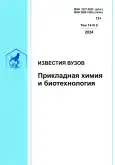Identification of iodothyronines in plant tissues
- Authors: Garipova M.I.1, Fedyaev V.V.1, Datsko O.I.1
-
Affiliations:
- Ufa University of Science and Technology
- Issue: Vol 14, No 2 (2024)
- Pages: 229-235
- Section: Physico-chemical biology
- URL: https://ogarev-online.ru/2227-2925/article/view/301315
- DOI: https://doi.org/10.21285/achb.917
- EDN: https://elibrary.ru/HEDYHU
- ID: 301315
Cite item
Full Text
Abstract
About the authors
M. I. Garipova
Ufa University of Science and Technology
Email: margaritag@list.ru
V. V. Fedyaev
Ufa University of Science and Technology
Email: vadim.fedyaev@gmail.com
O. I. Datsko
Ufa University of Science and Technology
Email: datsko87@list.ru
References
- Liu Y.-C., Yeh C.-T., Lin K.-H. Molecular functions of thyroid hormone signaling in regulation of cancer progression and anti-apoptosis // International Journal of Molecular Sciences. 2019. Vol. 20, no. 20. P. 4986. doi: 10.3390/ijms20204986.
- Bashkatov S.A., Garipova M.I. On the age-specific neurochemical and endocrine biomarkers of temperament traits in adolescents // Current Opinion in Behavioral Sciences. 2022. Vol. 43. P. 118–124. doi: 10.1016/j.cobeha.2021.09.002. EDN: IGMMDO.
- Yen P.M. Physiological and molecular basis of thyroid hormone action // Physiological Reviews. 2001. Vol. 81, no. 3. P. 1097–1142. doi: 10.1152/physrev.2001.81.3.1097.
- Garipova M.I., Usmanova R.R. 183 Isolation and partial characterization of a general hormone transporting blood protein complex // Journal of Biomolecular Structure and Dynamics. 2013. Vol. 31, no. s1. P. 118. doi: 10.1080/07391102.2013.786425.
- Köhrle J., Biebermann H. 3-Iodothyronamine – a thyroid hormone metabolite with distinct target profiles and mode of action // Endocrine Reviews. 2019. Vol. 40, no. 2. P. 602–630. doi: 10.1210/er.2018-00182.
- Lazcano I., Hernández-Puga G., Robles J.P., Orozco A. Alternative ligands for thyroid hormone receptors // Molecular and Cellular Endocrinology. 2019. Vol. 493. P. 110448. doi: 10.1016/j.mce.2019.05.007.
- Garipova M.I., Shigapova A.I., Farkhutdinov R.G., Fedyaev V.V., Sotnikova J.M., Yakupova A.B. The distribution of 3,5,3-triiodothyronine between the transport systems of blood and nuclei of the tissues // Journal of Biomolecular Structure and Dynamics (Book of Abstracts. Albany 2019: The 20th Conversation). 2019. Vol. 37, no. s1. P. 43–44. doi: 10.1080/07391102.2019.1604468.
- Souza P.C.T., Barra G.B., Velasco L.F.R., Ribeiro I.C.J., Simeoni L.A., Togashi M., et al. Helix 12 dynamics and thyroid hormone receptor activity: experimental and molecular dynamics studies of Ile280 mutants // Journal of Molecular Biology. 2011. Vol. 412, no. 5. P. 882–893. doi: 10.1016/j.jmb.2011.04.014.
- Goglia F., Moreno M., Lanni A. Action of thyroid hormones at the cellular level: the mitochondrial target // FEBS Letters. 1999. Vol. 452, no. 3. P. 115–120. doi: 10.1016/S0014-5793(99)00642-0.
- Гарипова М.И., Федяев В.В., Фархутдинов Р.Г., Сотникова Ю.М. Выявление соединения, антигеноподобного трийодтиронину, в клетках высших растений // Известия вузов. Прикладная химия и биотехнология. 2020. Т. 10. N 4. С. 639–646. doi: 10.21285/2227-2925-2020-10-4-639-646. EDN: CMWQLU.
- Рахманкулова З.Ф., Федяев В.В., Подашевка О.А., Усманов И.Ю. Альтернативные пути дыхания и вторичный метаболизм у растений с разными типами адаптивных стратегий при дефиците элементов минерального питания // Физиология растений. 2003. Т. 50. N 2. С. 231–237. EDN: OOULIH.
- Wang F., Xing J. Classification of thyroid hormone receptor agonists and antagonists using statistical learning approaches // Molecular Diversity. 2019. Vol. 23. P. 85–92. doi: 10.1007/s11030-018-9857-9.
- Chiellini G., Nguyen N.-H., Apriletti J.W., Baxter J.D., Scanlan T.S. Synthesis and biological activity of novel thyroid hormone analogues: 5’-aryl substituted GC-1 derivatives // Bioorganic & Medical Chemistry. 2002. Vol. 10, no. 2. P. 333–346. doi: 10.1016/s0968-0896(01)00284-x.
- Lim W., Nguyen N.-H., Yang H.Y., Scanlan T.S., Furlow J.D. A thyroid hormone antagonist that inhibits thyroid hormone action in vivo // Journal of Biological Chemistry. 2002. Vol. 277, no. 38. P. 35664–35670. doi: 10.1074/jbc.M205608200.
- Yoshihara H.A.I., Apriletti J.W., Baxter J.D., Scanlan T.S. A designed antagonist of the thyroid hormone receptor // Bioorganic & Medicinal Chemistry Letters. 2001. Vol. 11, no. 21. P. 2821–2825. doi: 10.1016/s0960-894x(01)00521-2.
- Lima S.T.C., Merrigan T.L., Rodrigues E.D. Synthetic and plant derived thyroid hormone analogs // Thyroid and parathyroid diseases – new insights into some old and some new issues / ed. L.S. Ward. In Tech, 2012. P. 221–235. doi: 10.5772/35134.
- Gupta A., Wamankar S., Gidwani B., Kaur C.D. Herbal drugs for thyroid treatment // International Journal of Pharmacy and Biological Sciences. 2016. Vol. 6, no. 1. P. 62–70.
- Mondal S., Mugesh G. Novel thyroid hormone analogues, enzyme inhibitors and mimetics, and their action // Molecular and Cellular Endocrinology. 2017. Vol. 458. P. 91–104. doi: 10.1016/j.mce.2017.04.006.
- Reis L.T.C., da Silva M.R.D., Costa S.L., Velozo E.D.S., Batista R., da Cunha Lima S.T. Estrogen and thyroid hormone receptor activation by medicinal plants from Bahia, Brazil // Medicines. 2018. Vol. 5, no. 1. P. 8. doi: 10.3390/medicines5010008.
- Hughes C.L. Phytochemical mimicry of reproductive hormones and modulation of herbivore fertility by phytoestrogens // Environmental Health Perspectives. 1988. Vol. 78. P. 171–174. doi: 10.1289/ehp.8878171.
- Гуссаковский Е.Е., Бабаев Т.А., Туракулов Я.Х. Простой спектрофотометрический метод количественного определения остатков иодаминокислот в иодированных белках // Биоорганическая химия. 1980. Т. 6. N 1. С. 46–50.
Supplementary files









